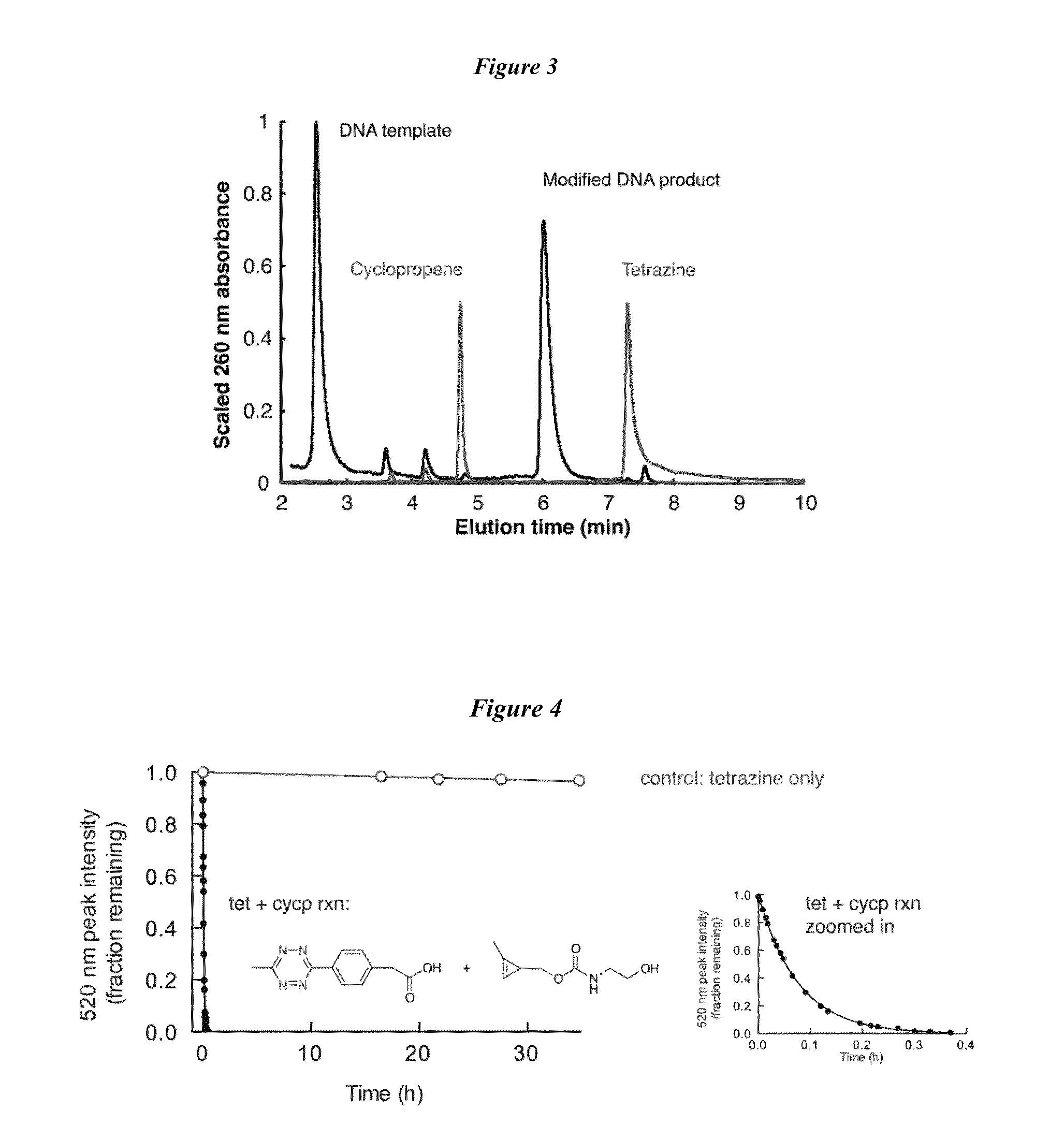Novel tetrazines and method of synthezising the same
a technology of tetrazines and synthesizers, applied in the field of new tetrazines and synthesizing the same, can solve the problems of a lack of convenient synthetic methods and a significant roadblock to broader use and study by the scientific community
- Summary
- Abstract
- Description
- Claims
- Application Information
AI Technical Summary
Problems solved by technology
Method used
Image
Examples
example 1
Starting Materials
[0201]All chemicals were received from commercial sources and used without further purification. End-modified DNA oligonucleotides were purchased from Integrated DNA Technologies, Inc and used after HPLC purification, lyophilization and resuspension in ddi H2O. DNA and RNA templates of 27-37 nucleotide length were purchased from IDT and used upon resuspension in ddi H2O without further purification.
DNA template:5′-TTG ACG CCA TCG AAG G[T]A GTG TTG AAT -3′(linker region underlined, single mismatch position in brackets);13merF15′tet:5′-tetrazine- / 5AmMC6 / / iFluorT / CG ATG GCG TCA A-3′(modified nucleotides indicated following the manufacturer′s nomenclature);13mer3′cyclopropene:5′-ATT CAA CAC TAC C / 3AmMO / -cyclopropene-3′;7mer3′cyclopropene:5′-CAC TAC C / 3AmMO / -cyclopropene-3′;5mer 3′cyclopropene:5′-CTA CC / 3AmMO / -cyclopropene-3′.
Synthesis of a Exemplary Tetrazine Tag
[0202]
[0203]To a stirred solution of tert-butyl 4-(6-methyl-1,2,4,5-tetrazin-3-yl)benzylcarbamate (10.0 mg, ...
example 2
Tissue Culture / Cell Growth Conditions
[0233]SKBR3 and LS 174T cells were grown in cDMEM media supplemented with 10% fetal bovine serum, 1% L-glutamine, 1% penicillin / streptomycin. Cells were incubated in 5.0% carbon dioxide, 95% humidity at 37° C. Generally, cells were grown in T-75 tissue culture flasks, seeded at densities between 500,000 and 750,000 cells per flask (cells were quantified with the Life Technologies Countess automated cell counter). The cells were trypsinized with TrypLE Express and resuspended in cDMEM. Cells were allowed to incubate for two days before supplementing with Ac4ManNCyc (N-cyclopropeneacetylmannosamine) or Ac4GlcNAz (N-azidoacetylglucosamine). The cells were then analyzed via confocal microscopy and flow cytometry as described below.
Live-Cell Microscopy
[0234]The SKBR3 and LS174T cells were incubated for two days in the presence of 100 μM of Ac4ManNCyc and / or 50 μM Ac4GlcNAz on a Lab-Tek chamber slide maintained in cDMEM medium. Treatment of cells with ...
example 3
General Methods
[0252]All chemicals were received from commercial sources and used without further purification. Thin layer chromatography (TLC) was performed on silica gel. Chromatographic purifications were conducted using 40-63 μm silica gel. All mixtures of solvents are given in v / v ratio. 1H and 13C NMR spectroscopy was performed on a Varian NMR at 500 (1H) or 125 (13C) MHz and a Jeol NMR at 500 (1H) or 125 (13C) MHz. All 13C NMR spectra were proton decoupled.
Synthetic Methods
1. Synthesis of Cyclopropene Amine 3
[0253]
[0254]Under the protection of N2, to a stirred solution of cyclopropene alcohol 1 (0.50 g, 3.2 mmol) in dry THF (10.0 mL) at 0° C. was added DBU (0.63 g, 4.2 mmol) followed by DPPA (Diphenylphosphoryl azide, 1.14 g, 4.2 mmol). The reaction solution was slowly warmed to room temperature and stirred overnight. After TLC indicated that the reaction had completed, most of the THF was evaporated by flushing compressed air and the material was passed through a short silic...
PUM
 Login to View More
Login to View More Abstract
Description
Claims
Application Information
 Login to View More
Login to View More - R&D
- Intellectual Property
- Life Sciences
- Materials
- Tech Scout
- Unparalleled Data Quality
- Higher Quality Content
- 60% Fewer Hallucinations
Browse by: Latest US Patents, China's latest patents, Technical Efficacy Thesaurus, Application Domain, Technology Topic, Popular Technical Reports.
© 2025 PatSnap. All rights reserved.Legal|Privacy policy|Modern Slavery Act Transparency Statement|Sitemap|About US| Contact US: help@patsnap.com



